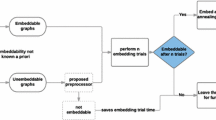Abstract
We show that the NP-hard quadratic unconstrained binary optimization (QUBO) problem on a graph G can be solved using an adiabatic quantum computer that implements an Ising spin-1/2 Hamiltonian, by reduction through minor-embedding of G in the quantum hardware graph U. There are two components to this reduction: embedding and parameter setting. The embedding problem is to find a minor-embedding G emb of a graph G in U, which is a subgraph of U such that G can be obtained from G emb by contracting edges. The parameter setting problem is to determine the corresponding parameters, qubit biases and coupler strengths, of the embedded Ising Hamiltonian. In this paper, we focus on the parameter setting problem. As an example, we demonstrate the embedded Ising Hamiltonian for solving the maximum independent set (MIS) problem via adiabatic quantum computation (AQC) using an Ising spin-1/2 system. We close by discussing several related algorithmic problems that need to be investigated in order to facilitate the design of adiabatic algorithms and AQC architectures.
Similar content being viewed by others
References
Aharonov, D., van Dam, W., Kempe, J., Landau, Z., Lloyd, S., Regev,O.: Adiabatic quantum computation is equaivalent to standard quantum computation. In: Proc. 45th FOCS, pp. 42–51 (2004)
Amin M.H.S., Love P.J., Truncik C.J.S.: Thermally assisted adiabatic quantum computation. Phys. Rev. Lett. 100, 060503 (2008)
Amin, M.H.S., Truncik, C.J.S., Averin, D.V.: The role of single qubit decoherence time in adiabatic quantum computation. arXiv:quant-ph/0803.1196 (2008)
Baker B.S.: Approximation algorithms for NP-complete problems on planar graphs. J. ACM 41(1), 153–180 (1994)
Bansal, N., Bravyi, S., Terhal, B.M.: A classical approximation scheme for the ground-state energy of Ising spin Hamiltonians on planar graphs. arXiv:quant-ph/0705.1115 (2007)
Barahona F.: On the computational complexity of Ising spin glass models. J. Phys. A: Math. Gen. 15, 3241–3253 (1982)
Boros E., Hammer P.: Pseudo-Boolean optimization. Discrete Appl. Math. 123, 155–225 (2002)
Boros, E., Hammer, P.L., Tavares, G.: Preprocessing of quadratic unconstrained binary optimization. Technical Report RRR 10-2006, RUTCOR Research Report (2006)
Bravyi, S., DiVincenzo, D.P., Loss, D., Terhal, B.M.: Simulation of many-body Hamiltonians using perturbation theory with bounded-strength interactions. arXiv:quant-ph/0803.2686 (2008)
Childs, A., Farhi, E., Preskill, J.: Robustness of adiabatic quantum computation. Phys. Rev. A 65, 012322 (10 pp.) (2001)
Diestel R.: Graph Theory. Springer-Verlag, Heidelberg (2005)
Farhi E., Goldstone J., Gutmann S., Lapan J., Lundgren A., Preda D.: A quantum adiabatic evolution algorithm applied to random instances of an NP-complete problem. Science 292(5516), 472–476 (2001)
Farhi, E., Goldstone, J., Gutmann, S., Sipser, M.: Quantum computation by adiabatic evolution. arXiv:quant-ph/0001106 (2000)
Ioannou, L.M., Mosca, M.: Limitations of some simple adiabatic quantum algorithms. arXiv:quant-ph/ 0702241 (2007)
Kaminsky W.M., Lloyd S.: Scalable architecture for adiabatic quantum computing of NP-hard problems. In: Leggett, A.J., Ruggiero, B., Silvestrini, P. (eds) Quantum Computing and Quantum Bits in Mesoscopic Systems, Kluwer, New York (2004)
Kaminsky, W.M., Lloyd, S., Orlando, T.P.: Scalable superconducting architecture for adiabatic quantum computation. arXiv:quant-ph/0403090 (2004)
Kempe J., Kitaev A., Regev., O: The complexity of the local Hamiltonian problem. SIAM J. Comput. 35, 1070 (2006)
Kleinberg, J.M., Rubinfeld, R.: Short paths in expander graphs. In: IEEE Symposium on Foundations of Computer Science, pp. 86–95 (1996)
Lidar, D.A., Rezakhani, A.T., Hamma, A.: Adiabatic approximation with better than exponential accuracy for many-body systems and quantum computation. arXiv:quant-ph/0808.2697 (2008)
Oliveira, R., Terhal, B.M.: The complexity of quantum spin systems on a two-dimensional square lattice. arXiv:quant-ph/0504050 (2005)
Reichardt, B.W.: The quantum adiabatic optimization algorithm and local minima. In: STOC ’04: Proceedings of the Thirty-sixth Annual ACM Symposium on Theory of Computing, pp. 502–510. ACM, New York, NY, USA (2004)
Robertson N., Seymour P.D.: Graph minors. xiii: the disjoint paths problem. J. Comb. Theory Ser. B 63(1), 65–110 (1995)
Thomson, L.F.: Introduction to Parallel Algorithms and Architectures: Arrays, Trees, Hypercubes. Morgan Kaufmann, San Mateo, California (1992)
van Dam, W., Mosca, M., Vazirani, U.: How powerful is adiabatic quantum computation? In: Proc. 42nd FOCS, pp. 279–287 (2001)
Author information
Authors and Affiliations
Corresponding author
Rights and permissions
About this article
Cite this article
Choi, V. Minor-embedding in adiabatic quantum computation: I. The parameter setting problem. Quantum Inf Process 7, 193–209 (2008). https://doi.org/10.1007/s11128-008-0082-9
Received:
Accepted:
Published:
Issue Date:
DOI: https://doi.org/10.1007/s11128-008-0082-9




